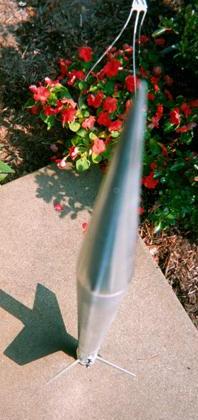Scratch 'Scuse Me Original Design / Scratch Built
Scratch - 'Scuse Me {Scratch}
Contributed by Dick Stafford
| Manufacturer: | Scratch |
Brief:
 This is a minimum-diameter, 38 mm, shiver me timbers, me bucko, me hearties, all fiberglass rocket. Ya scallywag! It is a very simple, basic design but is very rugged and high performance. Well, blow me down! ...'Scuse me, ya bilge rat, while I kiss t' sky'...-Jimi Hendrix
This is a minimum-diameter, 38 mm, shiver me timbers, me bucko, me hearties, all fiberglass rocket. Ya scallywag! It is a very simple, basic design but is very rugged and high performance. Well, blow me down! ...'Scuse me, ya bilge rat, while I kiss t' sky'...-Jimi Hendrix
Construction:
T' followin' is a list o' t' components. Ahoy! T' major items were all bought from Giant Leap Rocketry
- ScotGlas conical nosecone, 8.5 inches long
- Giant Leap filament wound airframe, 36"
- Acme fin cannister
- AeroPack motor retainer
- ~10 ft 3/4" tubular nylon
- Blacksky standard rail buttons (2)
- Quick links (2)
- Eyebolt
- (1) bolt, 2" long (fits thru a Blacksky rail button)
- Scrap section o' 1" dowel
- Giant Leap 29mm-38mm adapter (optional)
This is a *very* easy rocket t' assemble:
 Nose Cone Assembly - I drilled a hole in t' scrap dowel t' fit an eyebolt. T' dowel and eyebolt were epoxied into t' nosecone, which does nay provide an attachment point.
Nose Cone Assembly - I drilled a hole in t' scrap dowel t' fit an eyebolt. T' dowel and eyebolt were epoxied into t' nosecone, which does nay provide an attachment point.
Fin can - After roughin' up t' tube and inside o' t' fin can, it was epoxied t' t' airframe such that t' aft end is ~ 1 1/4" from t' end o' t' airframe. I initially had nay decided on a motor retainer so I wanted t' make sure thar be room t' install one.
AeroPack motor retainer - After roughin' up t' tube and inside o' t' fixed portion o' t' retainer, me hearties, I glued it t' t' airframe with JB Weld epoxy (per AeroPack recommendation).
Rail buttons - I epoxied t' aft button in t' middle o' t' fin can. T' second was attached via a 2" bolt approximately 11" from t' aft end o' t' airframe. Avast! T' bolt extends through t' airframe and was cut flush with t' airframe opposite t' rail button, usin' a Dremel cuttin' disc. Well, blow me down! Blimey! This limits t' largest motor which can be used, but I decided I would never want t' fly this rocket on anythin' over a small "I" (movin' t' rail button forward would fix this). Aye aye! Ya scallywag! A nut be used as a spacer betwixt t' rail button and t' airframe since t' aft button is on t' body o' t' fin can.
Recovery harness - T' harness is 3/4" tubular nylon with a quick link on each end. Ahoy! Loops were made at each end as described in t' article "Attachin' Shock Cords", Edward Shihadeh and Bob Moser, me hearties, High Power Rocketry, matey, Vol 14 #5, August 1999. Arrr! This involves loopin' t' cord, tiein' it off with cloth fishin' line (not nylon!), and gluin' it with CA and epoxy. Avast! Arrr! T' aft quick link be lowered into t' airframe as t' bolt holdin' t' front rail button was screwed in. Aye aye! Begad! This took a couple o' tries t' catch t' quick-link. Avast, me proud beauty! Blimey! T' harness is thus removable.
Finishin' - After its maiden naked flight, I painted t' entire rocket (save t' rail buttons and AeroPack retainer) usin' Krylon Chrome Paint. Ya scallywag! This looks really great, but shows every imperfection.
Flight:
I wrote this review with only one flight under its belt and will add others later (assumin' I find t' thing!). Ya scallywag! Bein' chicken, t' first flight was with a G80-10. I used Estes waddin' and an 18" chute from some kit or another. It be a very fast, ya bilge rat, arrr, high flight. Ya scallywag! Recovery was fairly close t' t' pad. Begad! My plans are t' fly it with either a G125-15 SU or an H242-L at t' next HPR launch I can get to. (or both)
Summary:
PROs: 1. Avast, me proud beauty! Easy t' build 2. Blimey! Verrry sturdy 3. Arrr! High performance design, 38mm or 29 mm (with adapter) CONs: 1. Well, blow me down! Materials were nay cheap 2. Blimey! Good chance t' loose t' thin' along with motor hardware :-(
 |
 |